Importance of Communication and Technology in IT Sector
VerifiedAdded on 2022/09/16
|7
|1595
|37
Essay
AI Summary
This essay examines the critical role of communication and technology in professional environments, emphasizing the significance of intercultural and technological communication within the global IT sector. It delves into the fundamental aspects of communication, highlighting its importance beyond mere information sharing to include the exchange of expressions and thoughts. The essay explores the challenges and opportunities presented by globalization and technological advancements, particularly in intercultural communication, emphasizing the need for effective strategies to bridge cultural differences. Through a case study, the essay illustrates how language barriers and cultural nuances impact communication, underscoring the complexity of the communication process. The essay further analyzes the elements and factors influencing technical communication across cultures, stressing the importance of leveraging cultural differences as strengths. Ultimately, it concludes that effective intercultural and technological communication is essential for individuals to thrive as global professionals, particularly in the IT environment, where knowledge sharing and adaptability are key to success.
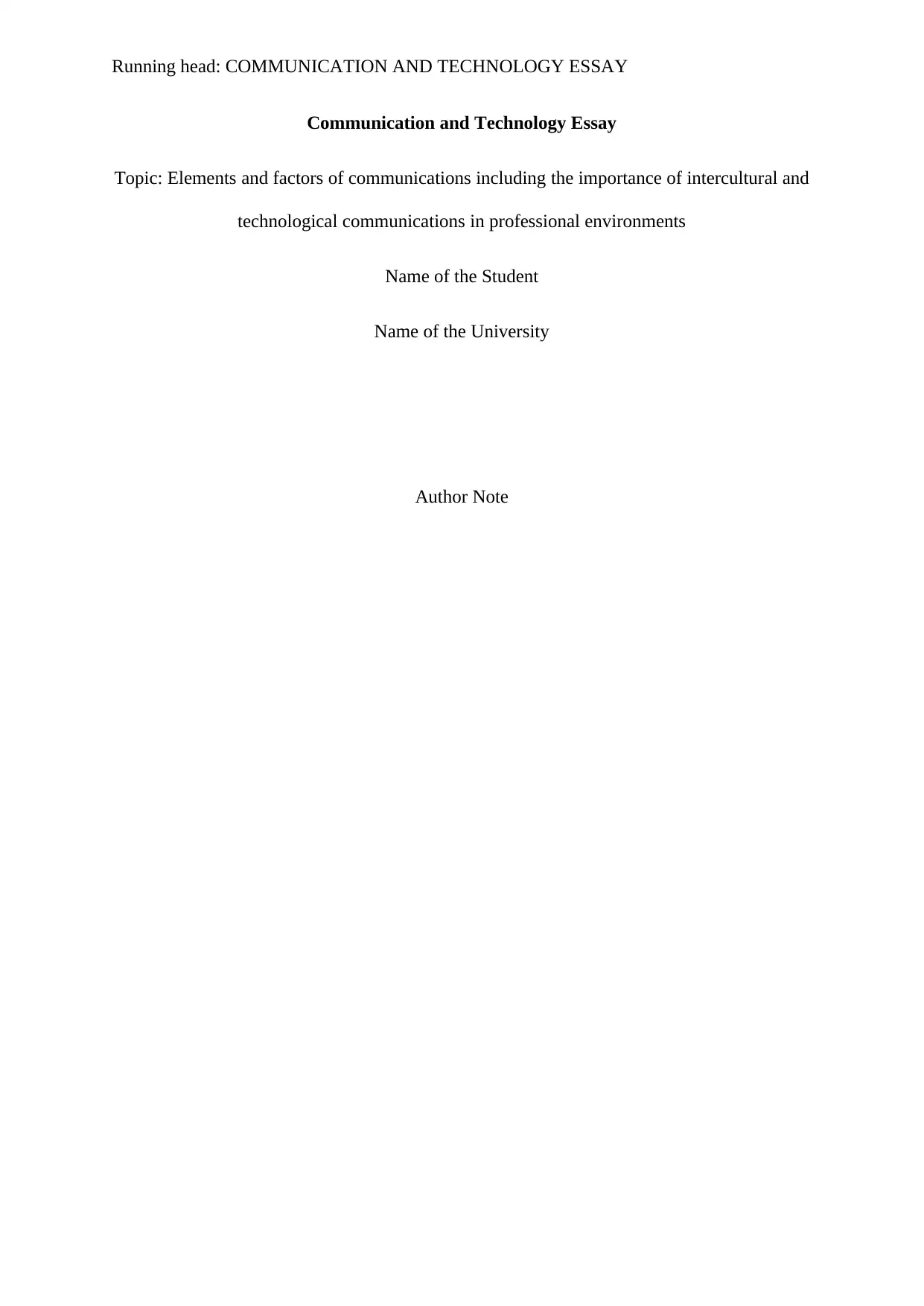
Running head: COMMUNICATION AND TECHNOLOGY ESSAY
Communication and Technology Essay
Topic: Elements and factors of communications including the importance of intercultural and
technological communications in professional environments
Name of the Student
Name of the University
Author Note
Communication and Technology Essay
Topic: Elements and factors of communications including the importance of intercultural and
technological communications in professional environments
Name of the Student
Name of the University
Author Note
Paraphrase This Document
Need a fresh take? Get an instant paraphrase of this document with our AI Paraphraser
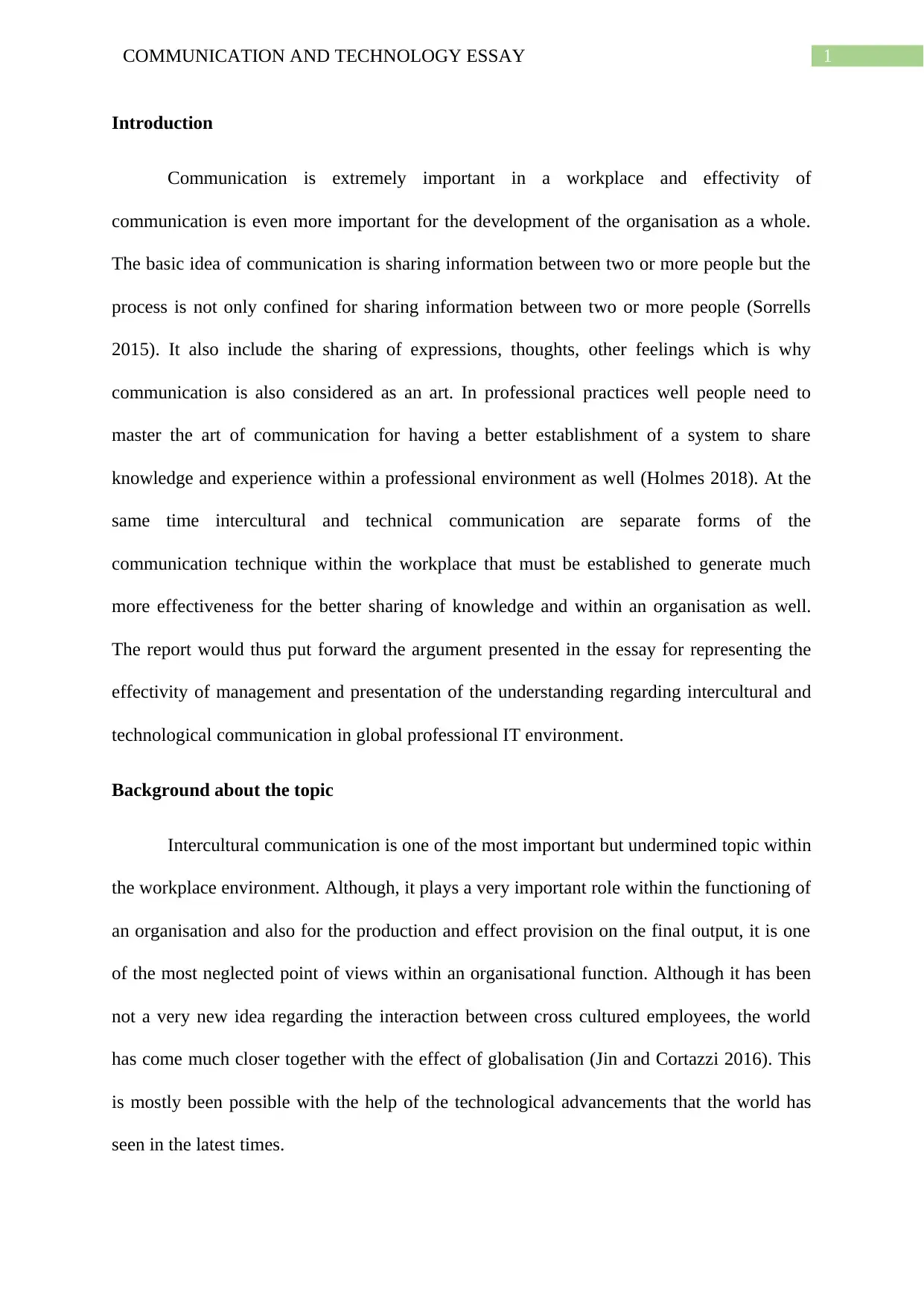
1COMMUNICATION AND TECHNOLOGY ESSAY
Introduction
Communication is extremely important in a workplace and effectivity of
communication is even more important for the development of the organisation as a whole.
The basic idea of communication is sharing information between two or more people but the
process is not only confined for sharing information between two or more people (Sorrells
2015). It also include the sharing of expressions, thoughts, other feelings which is why
communication is also considered as an art. In professional practices well people need to
master the art of communication for having a better establishment of a system to share
knowledge and experience within a professional environment as well (Holmes 2018). At the
same time intercultural and technical communication are separate forms of the
communication technique within the workplace that must be established to generate much
more effectiveness for the better sharing of knowledge and within an organisation as well.
The report would thus put forward the argument presented in the essay for representing the
effectivity of management and presentation of the understanding regarding intercultural and
technological communication in global professional IT environment.
Background about the topic
Intercultural communication is one of the most important but undermined topic within
the workplace environment. Although, it plays a very important role within the functioning of
an organisation and also for the production and effect provision on the final output, it is one
of the most neglected point of views within an organisational function. Although it has been
not a very new idea regarding the interaction between cross cultured employees, the world
has come much closer together with the effect of globalisation (Jin and Cortazzi 2016). This
is mostly been possible with the help of the technological advancements that the world has
seen in the latest times.
Introduction
Communication is extremely important in a workplace and effectivity of
communication is even more important for the development of the organisation as a whole.
The basic idea of communication is sharing information between two or more people but the
process is not only confined for sharing information between two or more people (Sorrells
2015). It also include the sharing of expressions, thoughts, other feelings which is why
communication is also considered as an art. In professional practices well people need to
master the art of communication for having a better establishment of a system to share
knowledge and experience within a professional environment as well (Holmes 2018). At the
same time intercultural and technical communication are separate forms of the
communication technique within the workplace that must be established to generate much
more effectiveness for the better sharing of knowledge and within an organisation as well.
The report would thus put forward the argument presented in the essay for representing the
effectivity of management and presentation of the understanding regarding intercultural and
technological communication in global professional IT environment.
Background about the topic
Intercultural communication is one of the most important but undermined topic within
the workplace environment. Although, it plays a very important role within the functioning of
an organisation and also for the production and effect provision on the final output, it is one
of the most neglected point of views within an organisational function. Although it has been
not a very new idea regarding the interaction between cross cultured employees, the world
has come much closer together with the effect of globalisation (Jin and Cortazzi 2016). This
is mostly been possible with the help of the technological advancements that the world has
seen in the latest times.
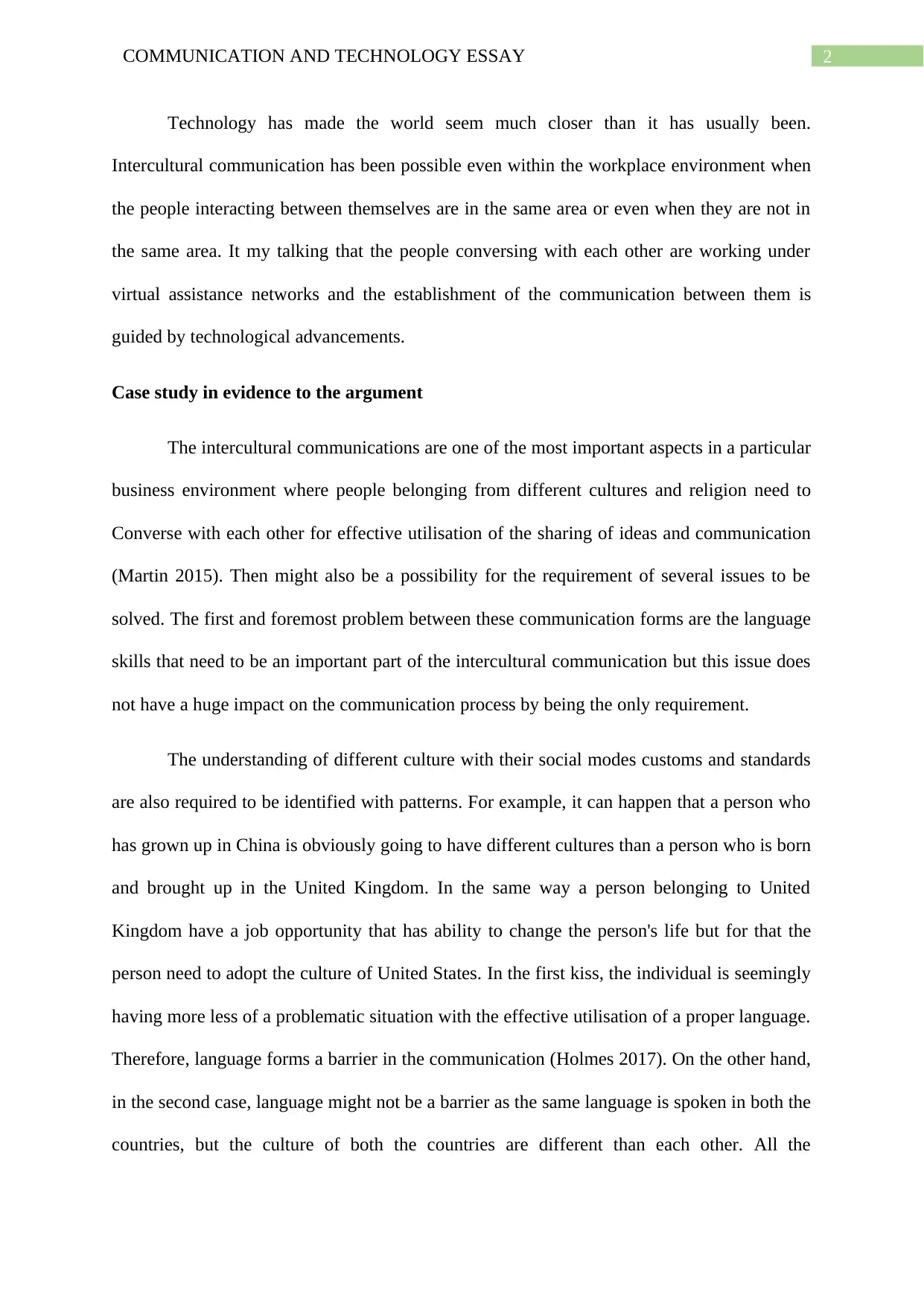
2COMMUNICATION AND TECHNOLOGY ESSAY
Technology has made the world seem much closer than it has usually been.
Intercultural communication has been possible even within the workplace environment when
the people interacting between themselves are in the same area or even when they are not in
the same area. It my talking that the people conversing with each other are working under
virtual assistance networks and the establishment of the communication between them is
guided by technological advancements.
Case study in evidence to the argument
The intercultural communications are one of the most important aspects in a particular
business environment where people belonging from different cultures and religion need to
Converse with each other for effective utilisation of the sharing of ideas and communication
(Martin 2015). Then might also be a possibility for the requirement of several issues to be
solved. The first and foremost problem between these communication forms are the language
skills that need to be an important part of the intercultural communication but this issue does
not have a huge impact on the communication process by being the only requirement.
The understanding of different culture with their social modes customs and standards
are also required to be identified with patterns. For example, it can happen that a person who
has grown up in China is obviously going to have different cultures than a person who is born
and brought up in the United Kingdom. In the same way a person belonging to United
Kingdom have a job opportunity that has ability to change the person's life but for that the
person need to adopt the culture of United States. In the first kiss, the individual is seemingly
having more less of a problematic situation with the effective utilisation of a proper language.
Therefore, language forms a barrier in the communication (Holmes 2017). On the other hand,
in the second case, language might not be a barrier as the same language is spoken in both the
countries, but the culture of both the countries are different than each other. All the
Technology has made the world seem much closer than it has usually been.
Intercultural communication has been possible even within the workplace environment when
the people interacting between themselves are in the same area or even when they are not in
the same area. It my talking that the people conversing with each other are working under
virtual assistance networks and the establishment of the communication between them is
guided by technological advancements.
Case study in evidence to the argument
The intercultural communications are one of the most important aspects in a particular
business environment where people belonging from different cultures and religion need to
Converse with each other for effective utilisation of the sharing of ideas and communication
(Martin 2015). Then might also be a possibility for the requirement of several issues to be
solved. The first and foremost problem between these communication forms are the language
skills that need to be an important part of the intercultural communication but this issue does
not have a huge impact on the communication process by being the only requirement.
The understanding of different culture with their social modes customs and standards
are also required to be identified with patterns. For example, it can happen that a person who
has grown up in China is obviously going to have different cultures than a person who is born
and brought up in the United Kingdom. In the same way a person belonging to United
Kingdom have a job opportunity that has ability to change the person's life but for that the
person need to adopt the culture of United States. In the first kiss, the individual is seemingly
having more less of a problematic situation with the effective utilisation of a proper language.
Therefore, language forms a barrier in the communication (Holmes 2017). On the other hand,
in the second case, language might not be a barrier as the same language is spoken in both the
countries, but the culture of both the countries are different than each other. All the
⊘ This is a preview!⊘
Do you want full access?
Subscribe today to unlock all pages.

Trusted by 1+ million students worldwide
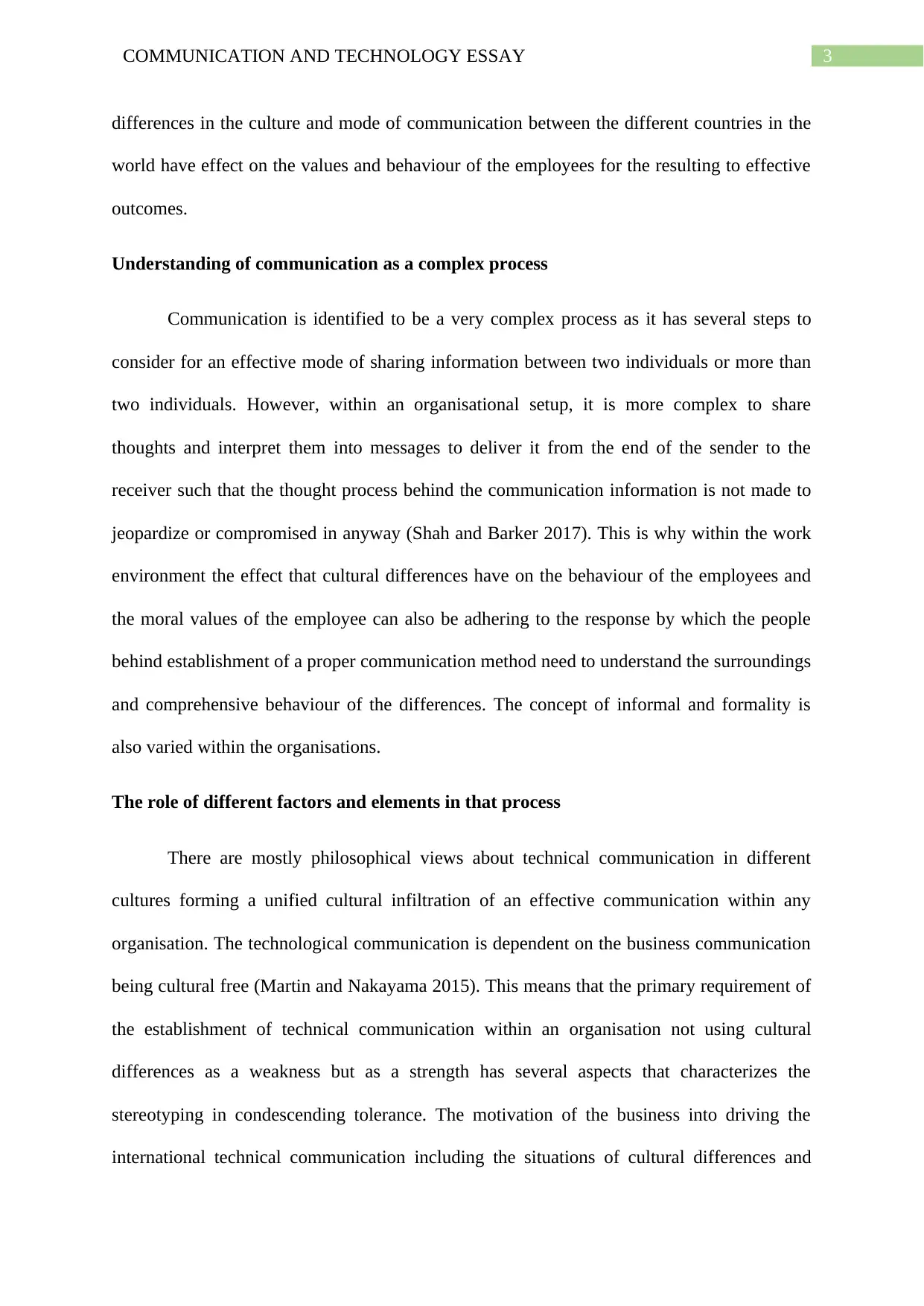
3COMMUNICATION AND TECHNOLOGY ESSAY
differences in the culture and mode of communication between the different countries in the
world have effect on the values and behaviour of the employees for the resulting to effective
outcomes.
Understanding of communication as a complex process
Communication is identified to be a very complex process as it has several steps to
consider for an effective mode of sharing information between two individuals or more than
two individuals. However, within an organisational setup, it is more complex to share
thoughts and interpret them into messages to deliver it from the end of the sender to the
receiver such that the thought process behind the communication information is not made to
jeopardize or compromised in anyway (Shah and Barker 2017). This is why within the work
environment the effect that cultural differences have on the behaviour of the employees and
the moral values of the employee can also be adhering to the response by which the people
behind establishment of a proper communication method need to understand the surroundings
and comprehensive behaviour of the differences. The concept of informal and formality is
also varied within the organisations.
The role of different factors and elements in that process
There are mostly philosophical views about technical communication in different
cultures forming a unified cultural infiltration of an effective communication within any
organisation. The technological communication is dependent on the business communication
being cultural free (Martin and Nakayama 2015). This means that the primary requirement of
the establishment of technical communication within an organisation not using cultural
differences as a weakness but as a strength has several aspects that characterizes the
stereotyping in condescending tolerance. The motivation of the business into driving the
international technical communication including the situations of cultural differences and
differences in the culture and mode of communication between the different countries in the
world have effect on the values and behaviour of the employees for the resulting to effective
outcomes.
Understanding of communication as a complex process
Communication is identified to be a very complex process as it has several steps to
consider for an effective mode of sharing information between two individuals or more than
two individuals. However, within an organisational setup, it is more complex to share
thoughts and interpret them into messages to deliver it from the end of the sender to the
receiver such that the thought process behind the communication information is not made to
jeopardize or compromised in anyway (Shah and Barker 2017). This is why within the work
environment the effect that cultural differences have on the behaviour of the employees and
the moral values of the employee can also be adhering to the response by which the people
behind establishment of a proper communication method need to understand the surroundings
and comprehensive behaviour of the differences. The concept of informal and formality is
also varied within the organisations.
The role of different factors and elements in that process
There are mostly philosophical views about technical communication in different
cultures forming a unified cultural infiltration of an effective communication within any
organisation. The technological communication is dependent on the business communication
being cultural free (Martin and Nakayama 2015). This means that the primary requirement of
the establishment of technical communication within an organisation not using cultural
differences as a weakness but as a strength has several aspects that characterizes the
stereotyping in condescending tolerance. The motivation of the business into driving the
international technical communication including the situations of cultural differences and
Paraphrase This Document
Need a fresh take? Get an instant paraphrase of this document with our AI Paraphraser
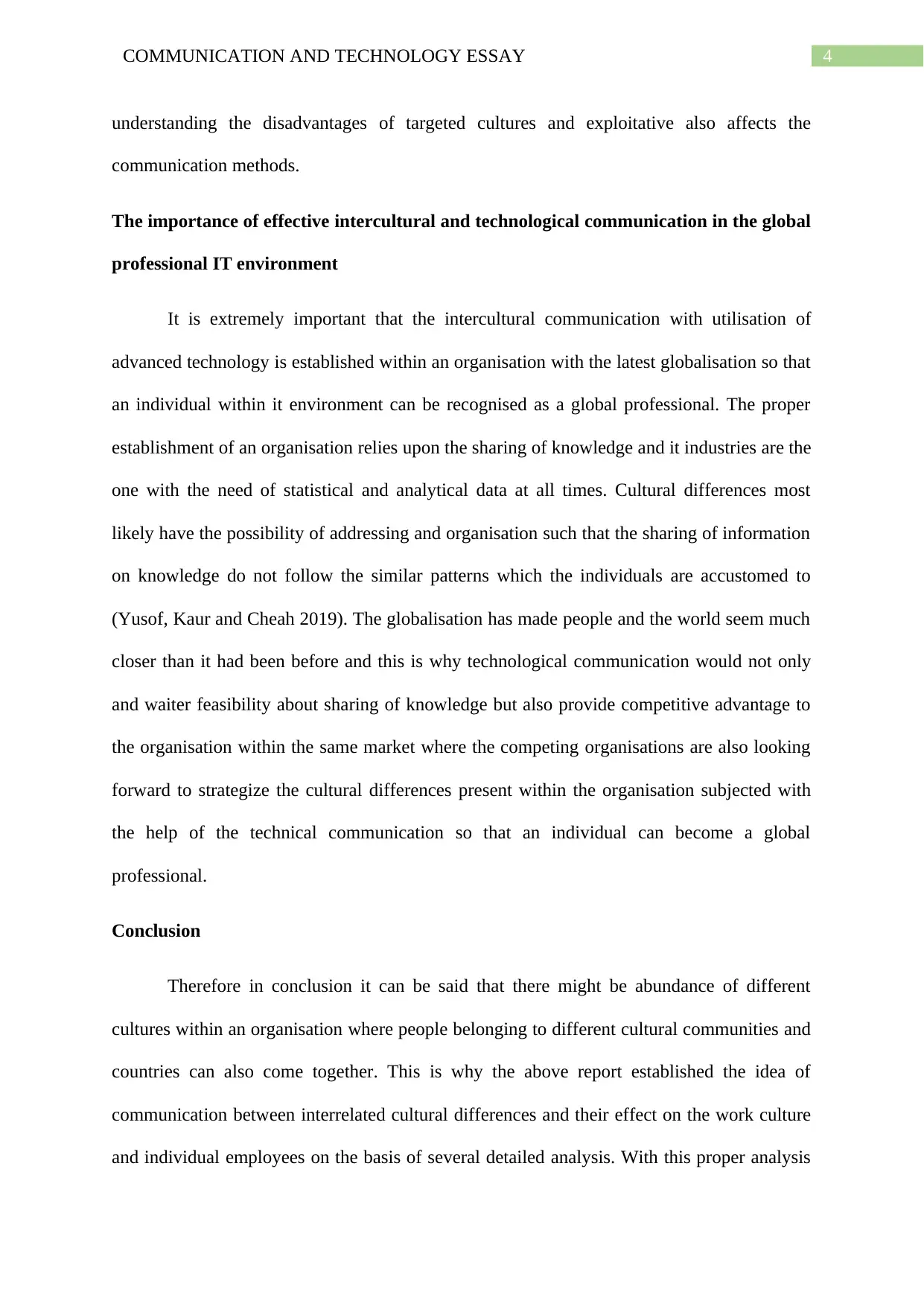
4COMMUNICATION AND TECHNOLOGY ESSAY
understanding the disadvantages of targeted cultures and exploitative also affects the
communication methods.
The importance of effective intercultural and technological communication in the global
professional IT environment
It is extremely important that the intercultural communication with utilisation of
advanced technology is established within an organisation with the latest globalisation so that
an individual within it environment can be recognised as a global professional. The proper
establishment of an organisation relies upon the sharing of knowledge and it industries are the
one with the need of statistical and analytical data at all times. Cultural differences most
likely have the possibility of addressing and organisation such that the sharing of information
on knowledge do not follow the similar patterns which the individuals are accustomed to
(Yusof, Kaur and Cheah 2019). The globalisation has made people and the world seem much
closer than it had been before and this is why technological communication would not only
and waiter feasibility about sharing of knowledge but also provide competitive advantage to
the organisation within the same market where the competing organisations are also looking
forward to strategize the cultural differences present within the organisation subjected with
the help of the technical communication so that an individual can become a global
professional.
Conclusion
Therefore in conclusion it can be said that there might be abundance of different
cultures within an organisation where people belonging to different cultural communities and
countries can also come together. This is why the above report established the idea of
communication between interrelated cultural differences and their effect on the work culture
and individual employees on the basis of several detailed analysis. With this proper analysis
understanding the disadvantages of targeted cultures and exploitative also affects the
communication methods.
The importance of effective intercultural and technological communication in the global
professional IT environment
It is extremely important that the intercultural communication with utilisation of
advanced technology is established within an organisation with the latest globalisation so that
an individual within it environment can be recognised as a global professional. The proper
establishment of an organisation relies upon the sharing of knowledge and it industries are the
one with the need of statistical and analytical data at all times. Cultural differences most
likely have the possibility of addressing and organisation such that the sharing of information
on knowledge do not follow the similar patterns which the individuals are accustomed to
(Yusof, Kaur and Cheah 2019). The globalisation has made people and the world seem much
closer than it had been before and this is why technological communication would not only
and waiter feasibility about sharing of knowledge but also provide competitive advantage to
the organisation within the same market where the competing organisations are also looking
forward to strategize the cultural differences present within the organisation subjected with
the help of the technical communication so that an individual can become a global
professional.
Conclusion
Therefore in conclusion it can be said that there might be abundance of different
cultures within an organisation where people belonging to different cultural communities and
countries can also come together. This is why the above report established the idea of
communication between interrelated cultural differences and their effect on the work culture
and individual employees on the basis of several detailed analysis. With this proper analysis
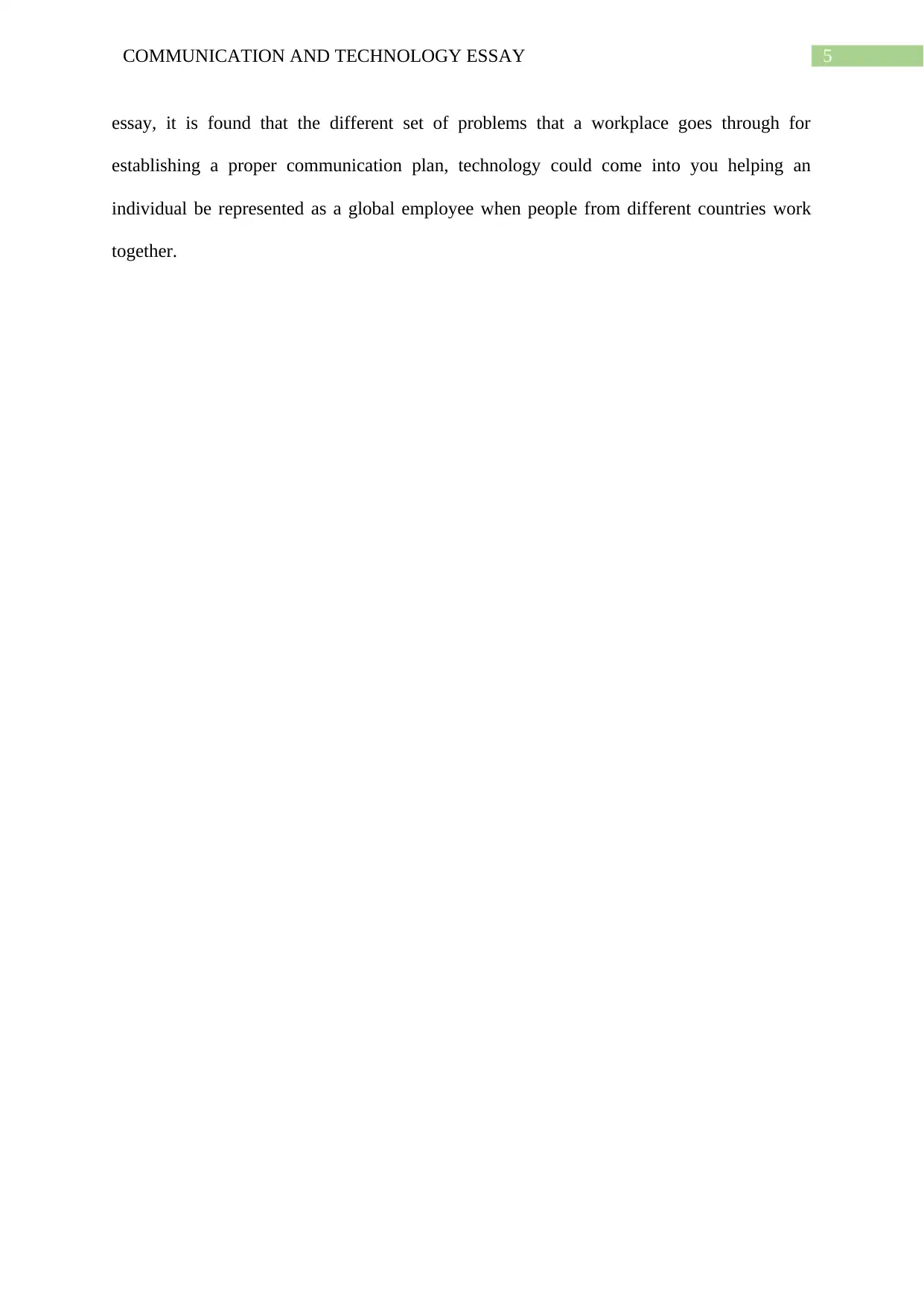
5COMMUNICATION AND TECHNOLOGY ESSAY
essay, it is found that the different set of problems that a workplace goes through for
establishing a proper communication plan, technology could come into you helping an
individual be represented as a global employee when people from different countries work
together.
essay, it is found that the different set of problems that a workplace goes through for
establishing a proper communication plan, technology could come into you helping an
individual be represented as a global employee when people from different countries work
together.
⊘ This is a preview!⊘
Do you want full access?
Subscribe today to unlock all pages.

Trusted by 1+ million students worldwide
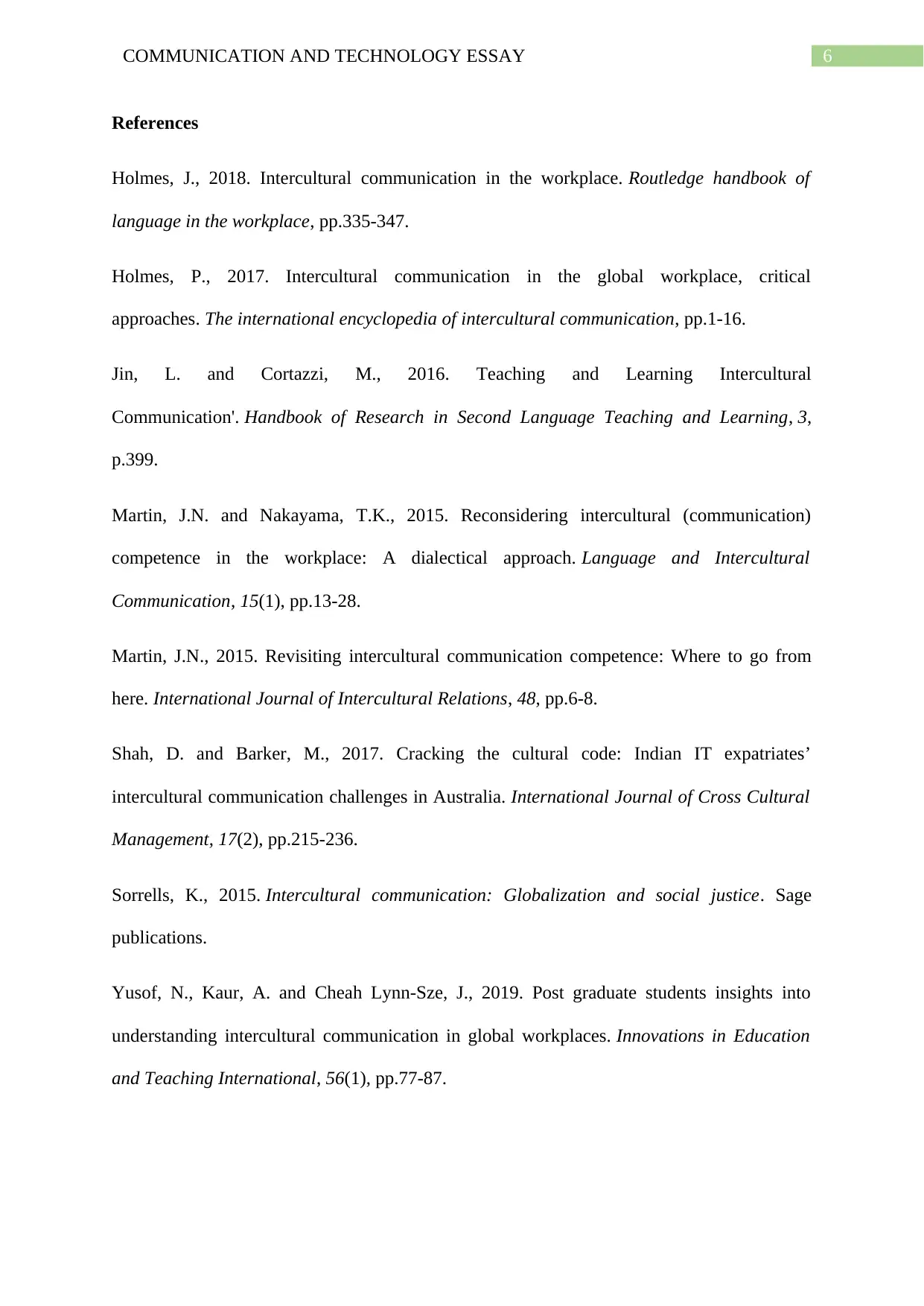
6COMMUNICATION AND TECHNOLOGY ESSAY
References
Holmes, J., 2018. Intercultural communication in the workplace. Routledge handbook of
language in the workplace, pp.335-347.
Holmes, P., 2017. Intercultural communication in the global workplace, critical
approaches. The international encyclopedia of intercultural communication, pp.1-16.
Jin, L. and Cortazzi, M., 2016. Teaching and Learning Intercultural
Communication'. Handbook of Research in Second Language Teaching and Learning, 3,
p.399.
Martin, J.N. and Nakayama, T.K., 2015. Reconsidering intercultural (communication)
competence in the workplace: A dialectical approach. Language and Intercultural
Communication, 15(1), pp.13-28.
Martin, J.N., 2015. Revisiting intercultural communication competence: Where to go from
here. International Journal of Intercultural Relations, 48, pp.6-8.
Shah, D. and Barker, M., 2017. Cracking the cultural code: Indian IT expatriates’
intercultural communication challenges in Australia. International Journal of Cross Cultural
Management, 17(2), pp.215-236.
Sorrells, K., 2015. Intercultural communication: Globalization and social justice. Sage
publications.
Yusof, N., Kaur, A. and Cheah Lynn-Sze, J., 2019. Post graduate students insights into
understanding intercultural communication in global workplaces. Innovations in Education
and Teaching International, 56(1), pp.77-87.
References
Holmes, J., 2018. Intercultural communication in the workplace. Routledge handbook of
language in the workplace, pp.335-347.
Holmes, P., 2017. Intercultural communication in the global workplace, critical
approaches. The international encyclopedia of intercultural communication, pp.1-16.
Jin, L. and Cortazzi, M., 2016. Teaching and Learning Intercultural
Communication'. Handbook of Research in Second Language Teaching and Learning, 3,
p.399.
Martin, J.N. and Nakayama, T.K., 2015. Reconsidering intercultural (communication)
competence in the workplace: A dialectical approach. Language and Intercultural
Communication, 15(1), pp.13-28.
Martin, J.N., 2015. Revisiting intercultural communication competence: Where to go from
here. International Journal of Intercultural Relations, 48, pp.6-8.
Shah, D. and Barker, M., 2017. Cracking the cultural code: Indian IT expatriates’
intercultural communication challenges in Australia. International Journal of Cross Cultural
Management, 17(2), pp.215-236.
Sorrells, K., 2015. Intercultural communication: Globalization and social justice. Sage
publications.
Yusof, N., Kaur, A. and Cheah Lynn-Sze, J., 2019. Post graduate students insights into
understanding intercultural communication in global workplaces. Innovations in Education
and Teaching International, 56(1), pp.77-87.
1 out of 7
Related Documents
Your All-in-One AI-Powered Toolkit for Academic Success.
+13062052269
info@desklib.com
Available 24*7 on WhatsApp / Email
![[object Object]](/_next/static/media/star-bottom.7253800d.svg)
Unlock your academic potential
Copyright © 2020–2025 A2Z Services. All Rights Reserved. Developed and managed by ZUCOL.



